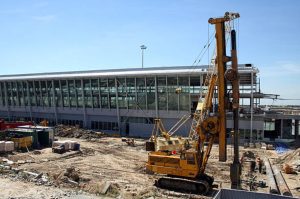Kolkata Airport Expansion: Netaji Subhas Chandra Bose International Airport (NSCBIA), located in Kolkata, is undergoing a massive expansion to cater to the rapidly increasing demand for air travel. With an anticipated nine-fold rise in passengers over the coming years, the airport is implementing both immediate and long-term infrastructural upgrades. These enhancements are designed to improve capacity, streamline passenger movement, and position Kolkata as a major aviation hub in Eastern India.
The expansion plan includes adding new terminals, increasing passenger-handling capacity, upgrading existing infrastructure, and implementing operational improvements that will transform NSCBIA into a world-class airport. This article delves into the details of the airport’s expansion project, its implications, and how it aligns with the broader vision of strengthening Kolkata’s aviation connectivity.
Kolkata Airport Expansion: Current Capacity and Immediate Expansion Efforts
At present, NSCBIA accommodates approximately 26 million passengers annually. However, with increasing domestic and international air traffic, this capacity is becoming insufficient. To address the growing passenger footfall, an interim expansion project is underway. This expansion aims to add 71,000 square feet to the integrated terminal.
Breakdown of Expansion Area:
- 60,200 square feet dedicated to the international terminal, improving immigration counters, waiting areas, and amenities.
- 10,800 square feet for the domestic terminal, ensuring better passenger movement and reducing congestion.


By optimizing existing infrastructure and utilizing underused spaces, these enhancements will increase the airport’s annual capacity to 28 million passengers. This expansion phase is expected to be completed by December 2025.
For official updates, visit the Airports Authority of India
Long-Term Expansion Strategy
Beyond the immediate enhancements, NSCBIA has embarked on an ambitious long-term plan that aims to construct a new integrated terminal (T2) north of the existing facility. This will be a game-changer for the airport, increasing its passenger-handling capacity to 39 million annually.
Investment & Phases
- The total investment for this massive expansion project stands at ₹5,000 crore.
- The project is divided into two phases, expected to be completed within six years.
- Once completed, NSCBIA will emerge as one of the most advanced airports in the country, rivaling other major hubs like Delhi and Mumbai.
Design & Features of the New Terminal
The newly planned Terminal 2 (T2) will span approximately 1.3 million square feet and will adopt a modern U-shaped design. This layout is being strategically implemented to optimize passenger flow, security checks, and overall efficiency.
Key Features:
- 21 aerobridges, enhancing seamless boarding and deboarding experiences.
- Additional check-in counters to reduce wait times and increase efficiency.
- Automated baggage handling systems for quicker luggage processing.
- Enhanced security infrastructure with state-of-the-art screening technology.
- Sustainable design elements including solar panels and energy-efficient systems.
- Expanded duty-free and retail zones to offer passengers a world-class shopping experience.
- Better food courts, lounges, and rest areas for greater passenger comfort.
This terminal will also have a direct connection to the metro system, allowing passengers easier access to and from the city, thereby improving last-mile connectivity.
Infrastructure Upgrades & Operational Enhancements
Alongside terminal expansions, several other key infrastructure improvements are being implemented:
1. New Air Traffic Control (ATC) Tower
- The new ATC tower will stand 51.4 meters tall, offering improved visibility and control over airport operations.
- The current ATC facility, in operation since the 1970s, will be replaced to accommodate the increased air traffic.
- The new tower is expected to be operational by late 2025.
2. Runway Upgrades
- The secondary runway will undergo recarpeting, allowing it to accommodate larger aircraft.
- The primary runway will also be enhanced with better lighting and navigational systems to support round-the-clock operations.
- Parallel taxiways are being introduced to reduce runway occupancy time and improve aircraft movement efficiency.
3. Increase in Aircraft Parking Bays
- The airport currently has 78 parking bays, which will be expanded to 105 by 2024.
- This will help in reducing aircraft congestion and ensuring smoother takeoff and landing schedules.
Phased Implementation & Timeline
The entire expansion plan is structured into multiple phases, ensuring minimal disruption to airport operations:
Phase 1 (2024-2026):
- Demolition of the old domestic terminal (T1).
- Construction of a new 7,000 square meter structure, connected to the existing terminal.
- Expansion of security hold areas and baggage claim zones.
- Introduction of new check-in counters and additional boarding gates.
Phase 2 (2026-2028):
- Demolition of the old Air Traffic Navigation Building.
- Development of new hangars and aircraft maintenance bays.
- Further expansion of international passenger terminals.
- Integration of metro rail connectivity within the terminal.
Upon completion of these phases, NSCBIA will be fully equipped to manage up to 45 million passengers annually, positioning itself as a key international gateway for India.
Projected Outcomes & Strategic Vision
With this comprehensive expansion, the Kolkata airport aims to achieve the following strategic milestones:
1. Increased Passenger Handling
- The airport’s capacity will almost double, making it one of the largest in India.
- Improved passenger flow management will ensure faster check-ins, security checks, and baggage clearance.
2. Enhanced International Connectivity
- The airport will add new global destinations, reconnecting Kolkata with major international hubs.
- Direct flights to cities like New York, London, Dubai, and Hong Kong are being planned.
3. Boost to the Regional Economy
- The expansion will create thousands of jobs in construction, aviation, retail, and hospitality.
- Enhanced connectivity will attract foreign investment, boosting trade and tourism in Eastern India.
4. Sustainable & Eco-Friendly Airport Design
- Implementation of green initiatives like solar power generation, rainwater harvesting, and electric vehicle usage.
- Energy-efficient cooling and lighting systems to reduce carbon emissions.
The expansion of Netaji Subhas Chandra Bose International Airport marks a significant transformation in Kolkata’s aviation landscape. With state-of-the-art infrastructure, increased passenger capacity, and improved international connectivity, NSCBIA is set to become a leading aviation hub in India.
Through careful planning and phased implementation, this ambitious project will ensure that Kolkata’s airport meets the growing demands of the future while also contributing to the region’s economic and infrastructural development.
As the city prepares to welcome millions of new flyers, this expansion project will play a crucial role in shaping the future of air travel in Eastern India, reinforcing Kolkata’s position on the global aviation map.
Also read: Home | Channel 6 Network – Latest News, Breaking Updates: Politics, Business, Tech & More


